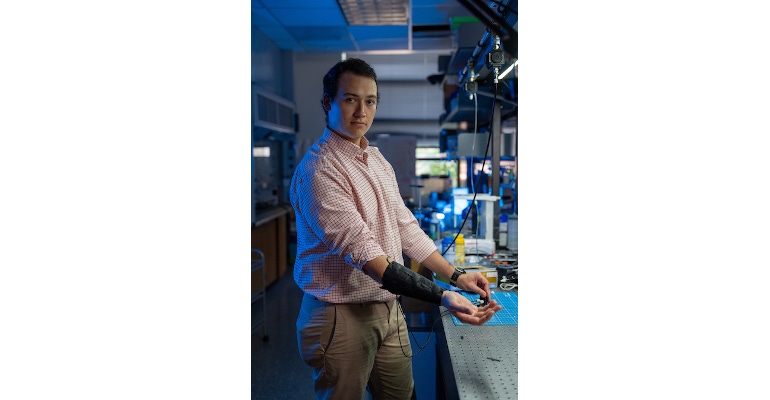Haptic-Enhanced Textiles Pave Way for More 'Immersive' World
A fluidics-based system controls the delivery of touch-based cues like vibration, tapping, and squeezing for a range of navigational, medical, and other wearable uses.
September 25, 2023

A new system that integrates touch-based communication into textiles paves the way for novel haptic systems that can streamline the development of more immersive wearable technology. Researchers from Rice University have developed a wearable, textile-based device that uses fluidic signals, such as pressures and flow rates, to control the delivery of complex haptic cues, including sensations like vibration, tapping, and squeezing.
The technology could be used in the future for a range of applications to provide sensory cues for navigation via smart clothing or other wearables in cases where vision or auditory cues would be difficult or impossible to achieve, they said. It also can preclude the need for bulky electrical or processing equipment currently required for wearable tech that incorporates haptics, noted Barclay Jumet, a mechanical engineering PhD student who worked on the research.
“Technology has been slow to co-opt haptics or communication based on the sense of touch,” he said in a post on Rice University's news site. “Of the technologies that have incorporated haptics, wearable devices often still require bulky external hardware to provide complex cues, limiting their use in day-to-day activities.”
Fluid in Form and Function
The wearable is composed of a belt and textile sleeves, with a small, lightweight carbon dioxide tank affixed to the belt that feeds airtight circuits incorporated in the heat-sealable textiles. This causes quarter-sized pouches—up to six on each sleeve—to inflate with varying force and frequency.
The type of fluidic control built into the system reduces the need for hardware by programming haptic cues into the textile structure of the wearables, said Daniel Preston, an assistant professor of mechanical engineering at Rice who co-led the research with Professor Marcia O'Malley. “With a traditional control system using voltage and current, you’d typically need many electronic inputs to achieve complex haptic cues,” Preston said. “In this device, we’ve offloaded a lot of that complexity to the fluidic controller and require only a very limited number of electronic inputs to provide sophisticated haptic stimulation.”
The team tested the durability of the haptic textiles by washing a device 25 times then cutting it open with a knife and ironing a textile patch over the cut, Jumet said. It continued to function even after this type of handling, demonstrating that the device is suitable for intensive daily use, he said.
Testing for Future Wearable Applications
Researchers also conducted several experiments to demonstrate the effectiveness of the device in various scenarios. In one that demonstrated the device’s utility for real-world navigation, the haptic cues served as directions guiding a user on a mile-long route through the streets of Houston. In another, a user was directed by haptic signals through the textiles tooutline invisible Tetris pieces in a field.
“In the future, this technology could be directly integrated with navigational systems, so that the very textiles making up one’s clothing can tell users which way to go without taxing their already overloaded visual and auditory senses—for instance by needing to consult a map or listen to a virtual assistant," Jumet explained.
The device also can have broad medical application, incorporating other sensing and control mechanisms to allow users with limited vision or hearing to detect obstacles and navigate dynamic environments in real time. Another application could be to help restore a sense of touch for an amputee by embedding sensors on a prosthesis that can gather data that the wearables could relay as haptic feedback elsewhere on the body, the researchers said.
Beyond these real-world examples, Jumet believes that haptic textiles also could have broader application that touches virtually everyone to “enable a more immersive and seamlessly connected world," he said.
“Instead of a smart watch with simple vibrational cues, we can now envision a ‘smart shirt’ that gives the sensation of a stroking hand or a soft tap on the torso or arm,” Jumet said. “Movies, games, and other forms of entertainment could now incorporate the sense of touch, and virtual reality can be more comfortable for longer periods of time.”
About the Author(s)
You May Also Like



